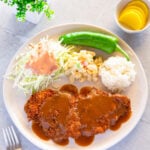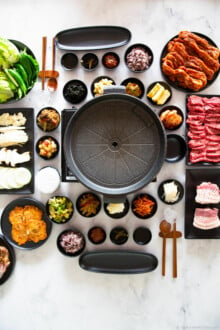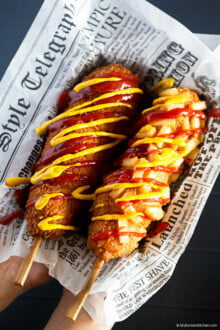Get ready to entice your taste buds with one of Korea’s most beloved dishes – Donkatsu, also known as Donkkaseu. This Japanese-inspired pork cutlet is a crispy yet juicy delight that will instantly make you fall in love. Whether you’re in the mood for a satisfying meal or simply craving something utterly delicious, donkatsu is the perfect choice.
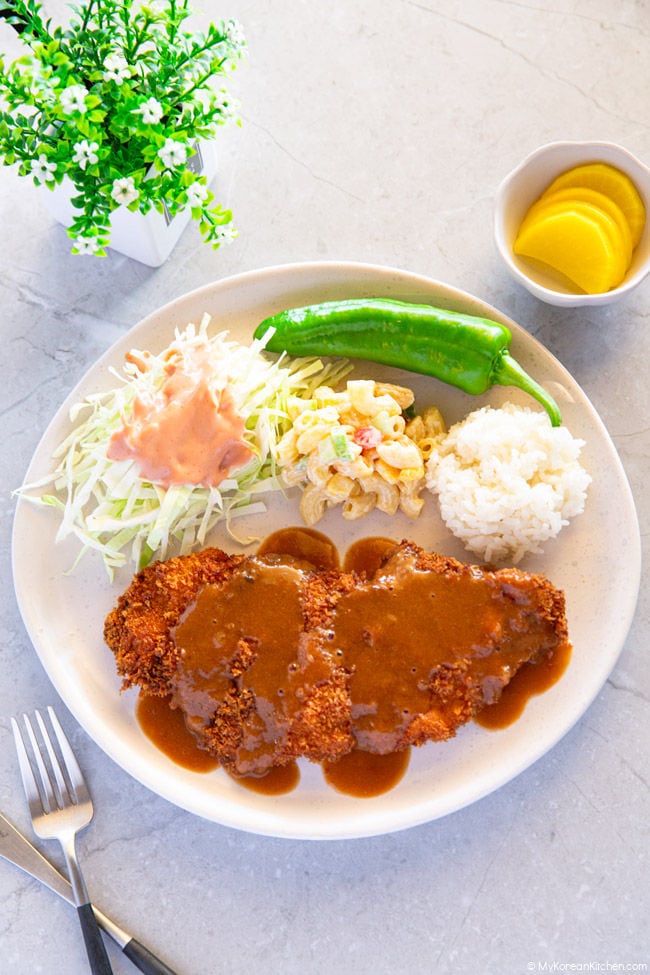
What is Donkatsu
Donkatsu, also known as Donkkaseu (돈까스), is often recognized as the Korean take on the popular Japanese dish, Tonkatsu. The name “ton” comes from pork, while “katsu” is derived from “cutlet.” The pork cutlet is coated in panko bread crumbs for a crispy texture and deep-fried to achieve a golden-brown exterior. Interestingly, Japanese Tonkatsu is said to be inspired by the French dish, côtelette de veau. – I thought Schnizel was the one. 🙂
Growing up in Korea as a kid, I used to believe donkatsu was a 100% Western dish. I mean, it came with a knife and fork – can you believe it? The novelty was incredible!
But that’s not all. While waiting for the mouth-watering donkatsu, they would serve a tempting cream soup as an appetizer, along with fresh morning bread rolls, strawberry jam, and butter, ready to accompany your donkatsu.
Now, if you’ve been sticking to the classic Korean lineup of rice, soup, and side dishes, you can easily imagine how extraordinary this must have felt! It was like stepping into a whole new world of culinary delights!
We eagerly anticipated these moments, especially on special occasions like birthdays or graduation celebrations.
Nowadays, with a wide variety of food available in Korea, donkatsu has lost some of its novelty. However, you can still find it easily in budget-friendly bunshik restaurants, the food court at highway rest stops, and school cafeterias. Korea also offers a diverse range of donkatsu dining establishments, including more authentic Japanese tonkatsu options.
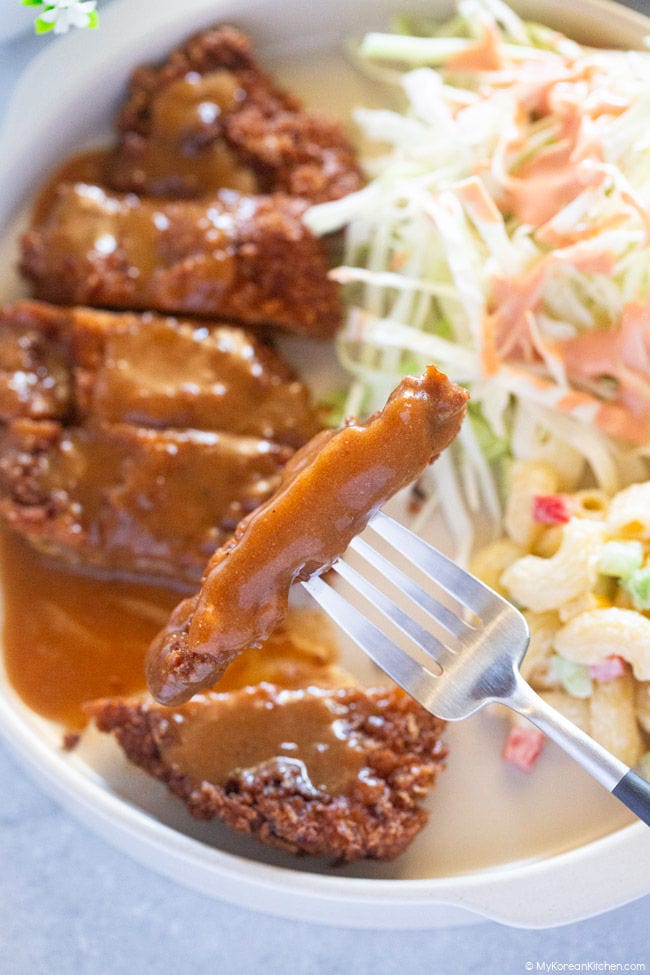
Japanese Tonkatsu vs. Korean Donkatsu
If you’re curious about the difference between Japanese Tonkatsu and Korean Donkatsu, you’ll find that many Koreans highlight the following factors as distinguishing. However, this comparison takes into account the entire meal, including the accompanying sauce and side dishes, not just the pork cutlet itself. I hope you find these distinctions fascinating to explore.
Thickness: This is one of the main points that most Koreans point out as a difference. Korean donkatsu meat usually boasts a thinner and larger profile compared to its Japanese counterpart, with the Korean version being said to be more crispy.
One of my favorite Korean-style donkatsu dishes is called Wang Donkatsu (왕 돈까쓰), typically characterized by its jumbo-sized, round pork cutlet. It’s not only filling but also visually appealing. However, I couldn’t get this jumbo-sized pork loin for my recipe, so mine doesn’t appear as large in the images throughout this post.
The image below is of the famous Namsan Wang Donkatsu (남산 왕돈까쓰) that I tried during my recent visit to Korea.
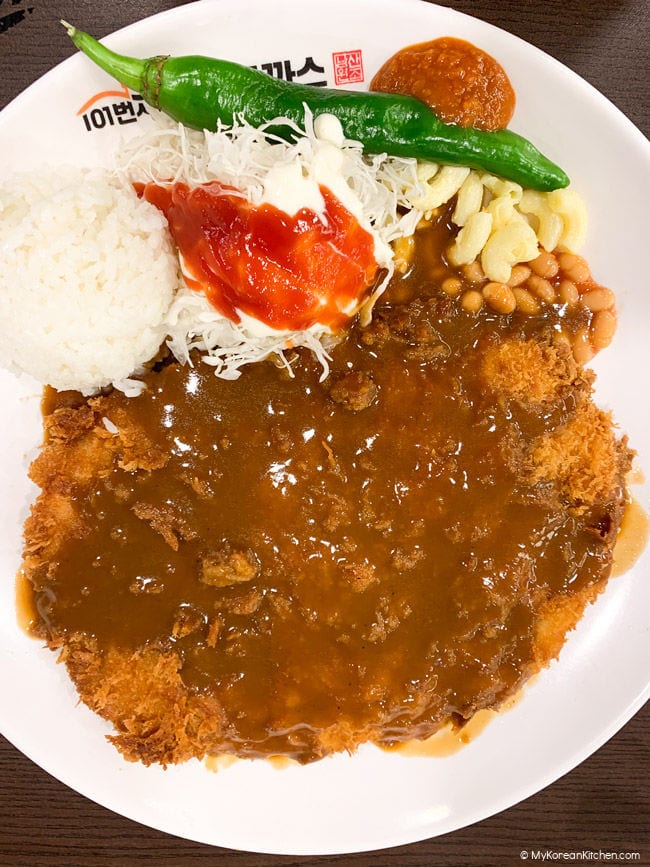
Sauce: Japanese tonkatsu sauce typically has a thick consistency and features a sweet and tangy flavor derived from ketchup and Worcestershire sauce. I notice the tangy flavor in Japanese tonkatsu sauce is particularly robust compared than Korean sauce. In addition, it is a much darker brown color compared to its Korean counterpart.
In contrast, the Korean version has a somewhat buttery aftertaste while simultaneously maintaining a savory, sweet, and tangy profile. However, it’s crucial to note that taste differences can be subjective, as individual experiences may differ. These variations can depend on the specific restaurant visited or the home-cooked versions one grew up with.
Serving Style: Korean donkatsu is typically served as a large, uncut piece, accompanied by a knife and fork. In contrast, Japanese tonkatsu is pre-sliced and meant to be enjoyed using chopsticks.
Side Dishes: Japanese tonkatsu is typically served with shredded cabbage, miso soup, and rice. In contrast, Korean donkatsu usually comes with pickled radish or cucumber (or kimchi), rice, and macaroni salad. It is also often accompanied by a creamy and savory cream soup, providing a filling meal.
Even more uniquely, you might come across ssamjang (a Korean spicy dipping sauce) and long green peppers as side options. The combination of these distinct Korean ingredients with donkatsu may seem unusual, but they work together beautifully.
Trying both Korean and Japanese tonkatsu firsthand is definitely the best way to truly appreciate and understand the differences between them. Personal tastes and experiences play a big role in determining which one you might prefer.
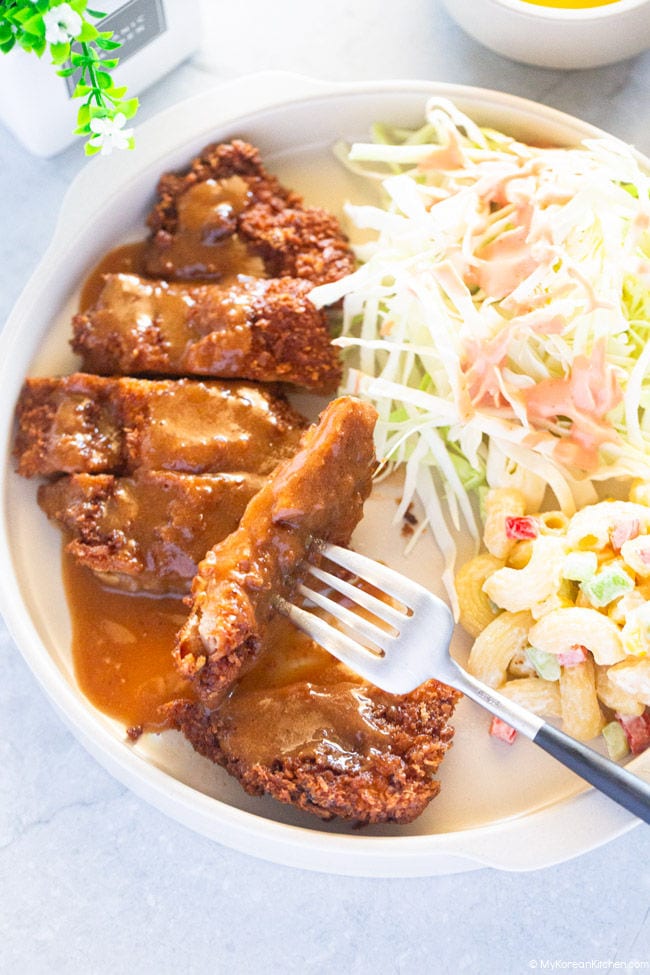
My Best Tips for Perfect Donkatsu
Best Cuts of Meat
When it comes to making donkatsu, the perfect cut of pork is pork loin fillet. Some Korean grocers offer pork cutlets specially prepared for donkatsu. These expertly sliced pieces boast slits throughout the meat, tenderizing the pork and also flattening the meat helping fast even cooking.
However, if you can’t obtain these prepared pork loins, there’s no need to worry as they’re easy to prepare at home.
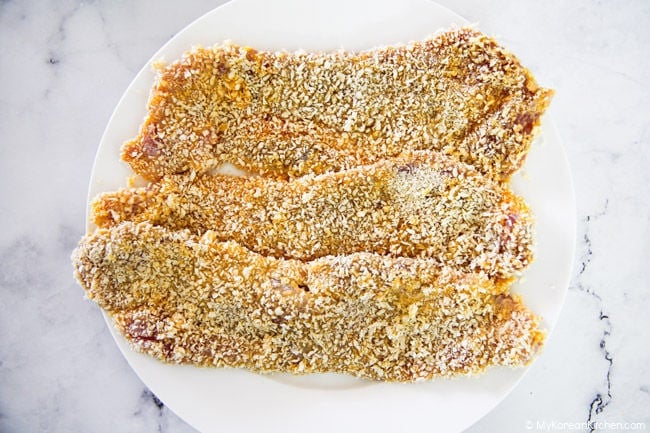
Ideally, the meat should be about 1cm / 0.4 inches thick. If possible, ask your butcher to slice it for you so that you have one less thing to prepare. If your butcher is unfamiliar with Asian cuisine, mention that you’re making schnitzel with the meat; they’ll then understand the required thinness.
Keeping Deep Fry Oil Fresh
To maintain the deep frying oil in optimal condition and prevent any discoloration or adverse effects on the donkatsu coating, it’s advisable to quickly clean it between batches. Just use a fine-mesh strainer to skim off any remaining fried crumbs from the oil’s surface – it’s as simple as that!
Preparing in Advance & Guidelines for Storage
You can prepare donkatsu ahead of time, and there are a couple of ways to do this.
Firstly, you can prepare the pork loin up to the breading step in advance. Keep the breaded pork in the refrigerator for up to 4 hours before cooking to ensure optimal flavor and texture.
Alternatively, if you prefer to cook and freeze your donkatsu, that’s also an option. After cooling, individually wrap the donkatsu in cling wrap and place them in a ziplock bag or freezer bag. When ready to eat, simply take it out of the freezer and reheat in the air fryer at 200 degrees Celsius for 10 minutes, flipping halfway through. If you plan to consume it within a few days, fried donkatsu can be refrigerated instead. In this case, reheat in the air fryer at 200 degrees Celsius for 5 minutes.
Lastly, donkatsu sauce can be prepared in advance (2 to 3 days) and stored in an airtight container in the refrigerator until you’re ready to enjoy.
How to Serve
As previously mentioned, Korean donkatsu is typically served unsliced, making it perfect for enjoying with a knife and fork rather than chopsticks. In addition, the pork cutlet is presented already covered in brown sauce, rather than having the sauce served separately.
Regarding the sides, they can include shredded cabbage dressed with a blended ketchup-mayonnaise sauce, baked beans, Korean macaroni salad, sweet corn, and danmuji (yellow pickled radish) or pickled cucumber. For added texture and a hint of spice, non-spicy green chili peppers can be served alongside ssamjang (Korean spicy dipping sauce) for dipping.
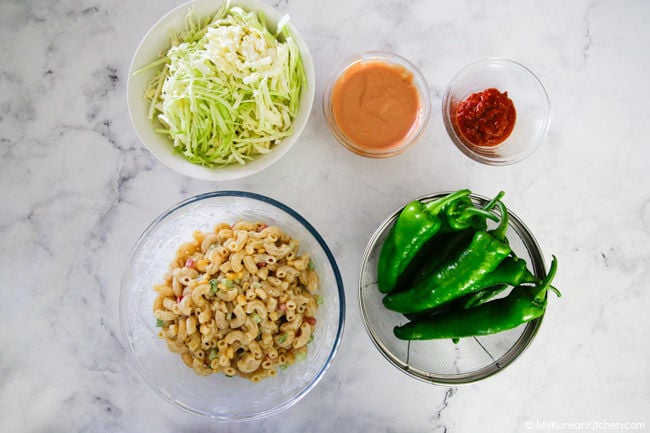
To infuse more Korean flavor, you can consider serving baechu kimchi (napa cabbage kimchi) or kkakdugi (radish kimchi), as well as a bowl of rice.
Other Recipes You Might Like
Check out these successfully Koreanized dishes that are inseparable to many people in Korea! Give them a try and see what they’re all about!
- Omurice (Omelette Rice)
- Tangsuyuk (Korean Sweet and Sour Pork)
- Jajangmyeon (Korean Black Noodles)
- Triangle Kimbap (Samgak Kimbap)
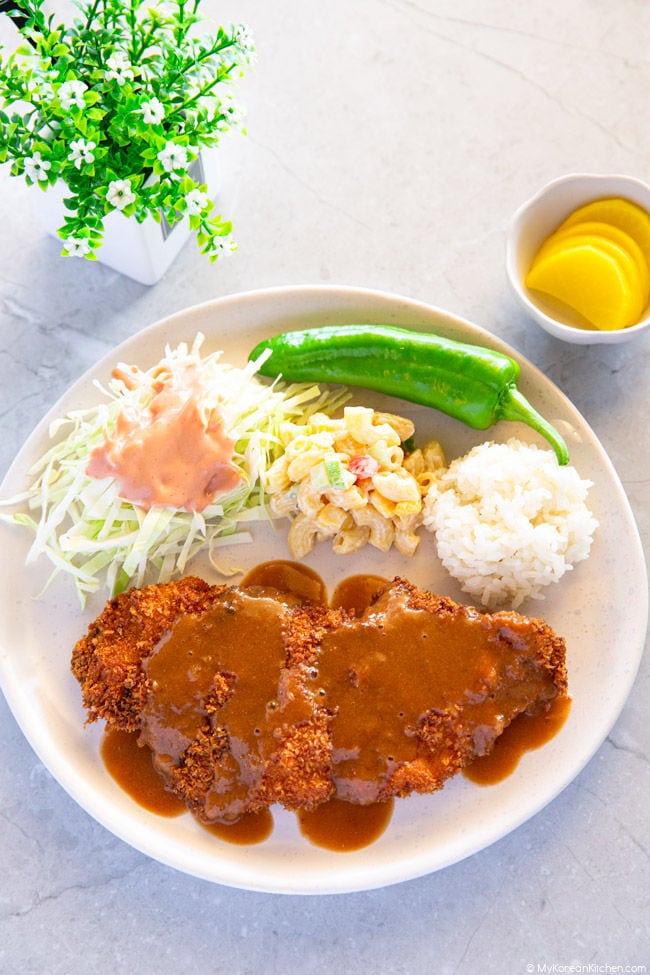
Ingredients for Donkatsu
Donkatsu Sauce
- 1/4 cup ketchup
- 1/2 cup tonkatsu sauce, bulldog brand preferred
- 2 Tbsp brown sugar
- 1 1/2 cup water
- 1/2 cup milk
- 30g / 1 ounce salted butter
- 1 1/2 Tbsp plain flour
- 1/2 Tbsp cornstarch
- 1 Tbsp water
Pork Cutlet
- 600g / 1.3 pound pork loin (cut thinly for pork cutlet), about 1 cm / 0.4 inch thickness
- milk, enough to soak the meat
- 3 eggs
- 1/2 cup plain flour
- 1/2 tsp garlic powder
- 1/2 tsp onion powder
- 1 1/2 cup panko bread crumbs
Sides (Optional)
- 250g / 9 ounce cabbage, thinly sliced
- 1/3 cup ketchup
- 1/3 cup mayonnaise
- non-spicy chili (e.g. cucumber chili)
- ssamjang
- macaroni salad
- cooked rice
- pickled cucumber
- danmuji (yellow pickled radish)
- kimchi
*1 Tbsp = 15 ml, 1 Cup = 250 ml
How to Make Donkatsu
Donkatsu Sauce
1. Combine ketchup, tonkatsu sauce, brown sugar, water and milk in a large bowl or measuring cup. Mix well and set aside.
2. Preheat a frying pan over medium heat, then add the butter. Once the butter has melted, add the flour to the pan. Stir well to ensure the flour is thoroughly mixed with the butter. Continue to cook over medium to medium-high heat until the mixture turns dark brown; this should take approximately 5-7 minutes, with occasional stirring. Then, reduce the heat to low.
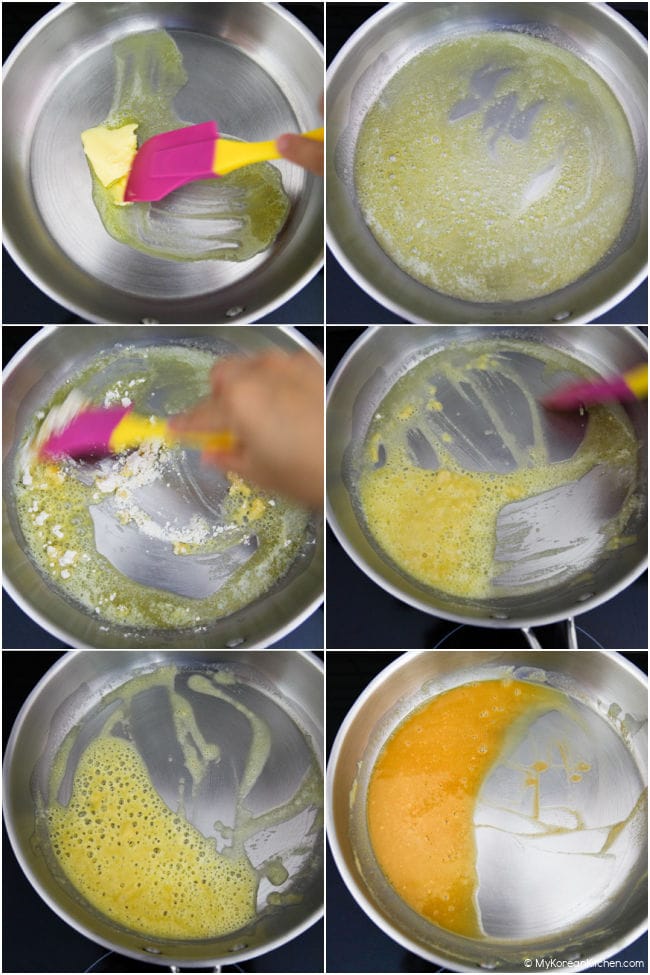
3. Pour the brown sauce from step 1 into the pan, stirring well. Increase the heat to medium-low or medium and cook until the sauce thickens, which should take approximately 8-10 minutes; remember to stir often. In a separate bowl, combine the cornstarch and water, whisking until the starch dissolves completely. Once the sauce in the pan has thickened slightly, add the slurry. Continue to stir frequently for an additional 5 minutes, or until the sauce reaches your desired thickness. Once done, either set it aside or reduce the heat to the lowest setting to keep it warm while the pork cutlet is being cooked.
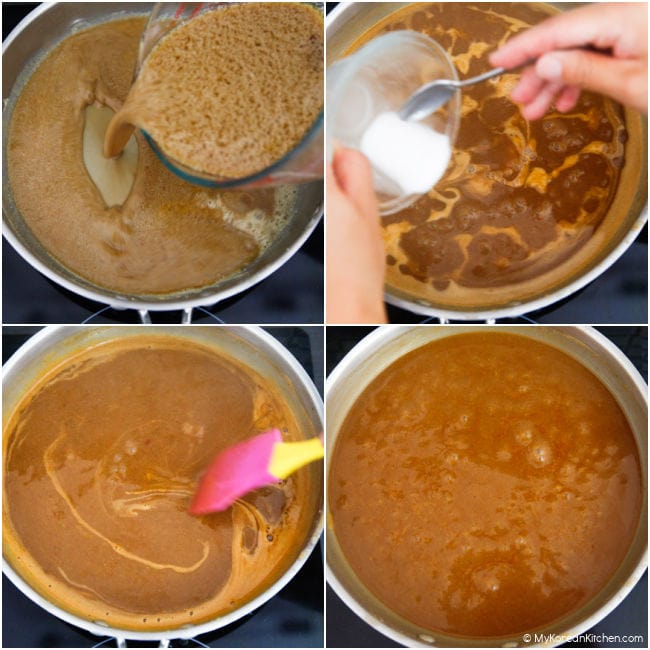
Pork Cutlet
1. Lightly score the meat in a diamond pattern using a knife, or use a mallet to tenderize it. Next, place the meat in a bowl and pour in the milk. Let the meat soak in the milk for 10 minutes. This will help further tenderize the meat and reduce any gamey smell. Afterward, drain the milk away and set the meat aside.
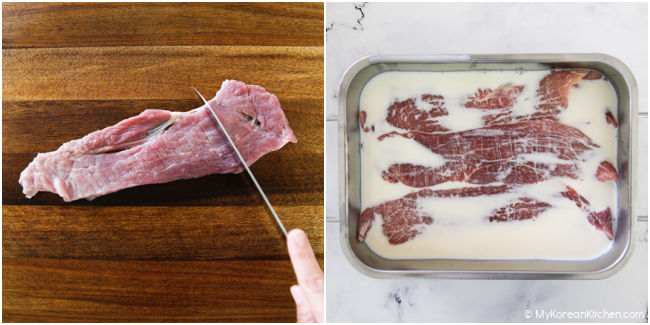
2. Prepare two separate plates; fill one with a mixture of flour, garlic powder, and onion powder, and the other with panko bread crumbs. In a medium-sized bowl, crack the eggs and whisk them until fully combined. Arrange your workstation in the following order: a plate of pork, a plate of the flour mixture, a bowl of whisked eggs, and finally, a plate of panko bread crumbs.
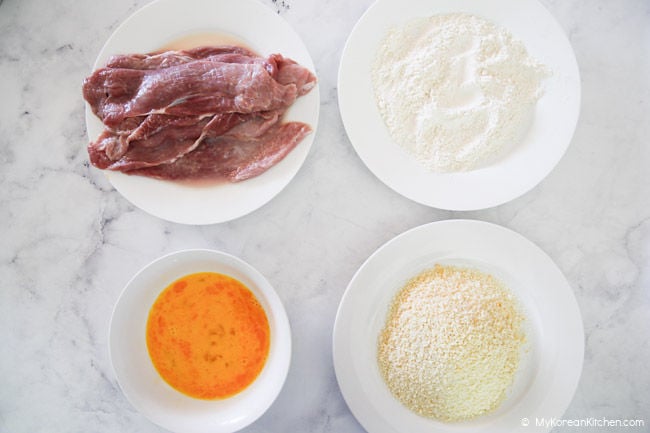
3. Thoroughly coat all sides of the pork with flour, then dip it into the beaten eggs. Finally, roll it in the panko bread crumbs until it’s fully covered. Repeat this process until all the meat is fully breaded.
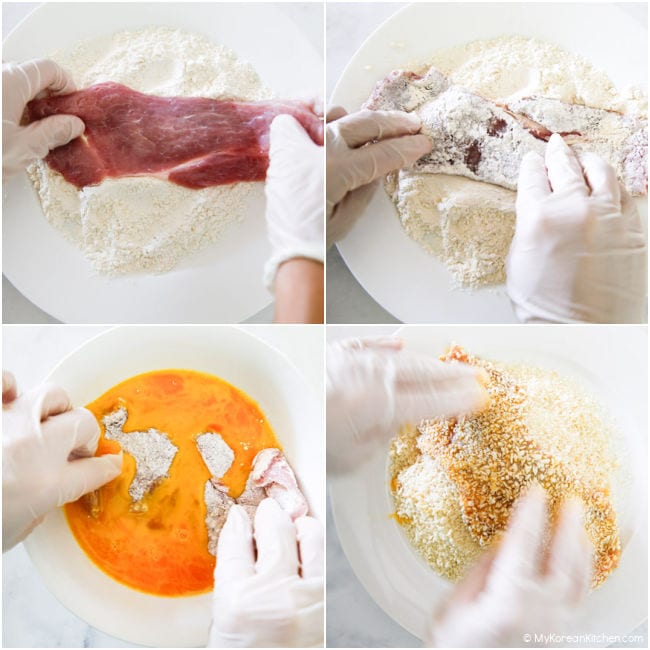
4. To prepare for frying, fill a fryer or large deep pan with a generous amount of oil and heat it. Make sure the container is wide enough to fully immerse at least one pork cutlet. Once the oil reaches 175°C (350°F), it is ready—this usually takes about five minutes on medium-high heat.
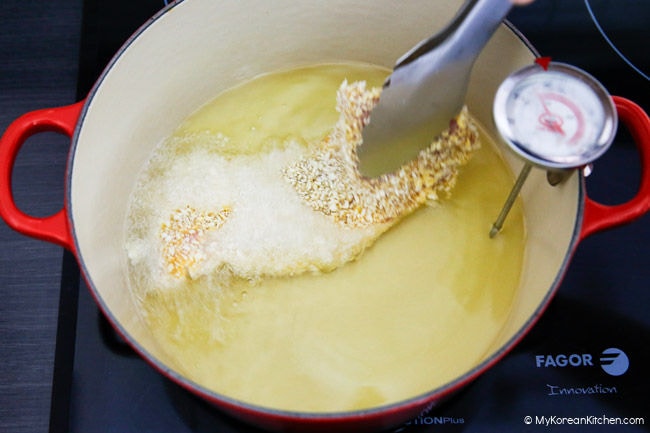
5. Carefully place the pork cutlet in the sizzling oil and fry for about four minutes, flipping it every one to two minutes for even cooking. Once the pork cutlet is fully cooked and golden-brown, remove it from the oil and place on paper towels to absorb excess oil. Using a fine-mesh strainer, quickly skim off any remaining fried crumbs from the surface of the oil between batches. Repeat this process until all the cutlets are fried.
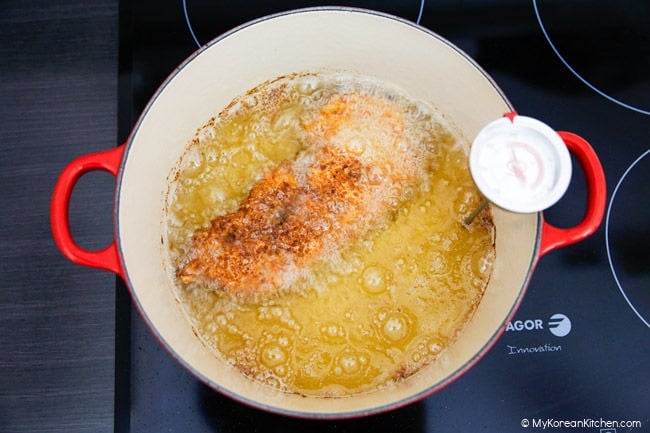
6. Serve your chosen sides on a large plate, arranged around the edge. If serving cabbage, combine the ketchup and mayonnaise in a small bowl, then dollop the sauce over the cabbage. Place the cutlet in the center of the plate. Drizzle the sauce over it. Enjoy!
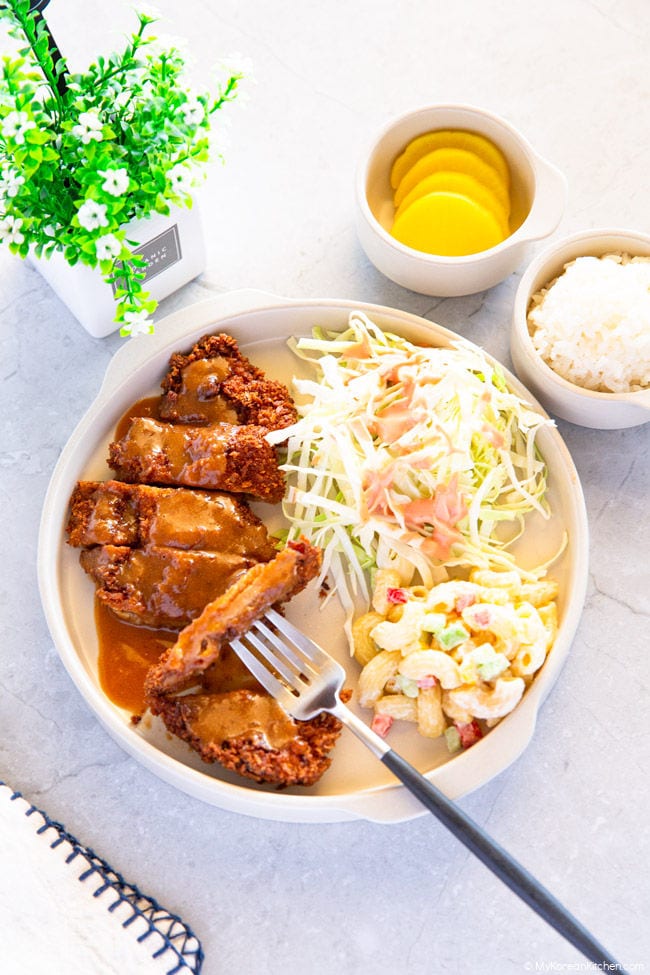
Love Korean food? Browse even more delicious ideas from my collection of easy Korean recipes. Don’t forget to subscribe to my newsletter to stay updated on new recipes, what the MKK community is cooking, and K-Dramas!
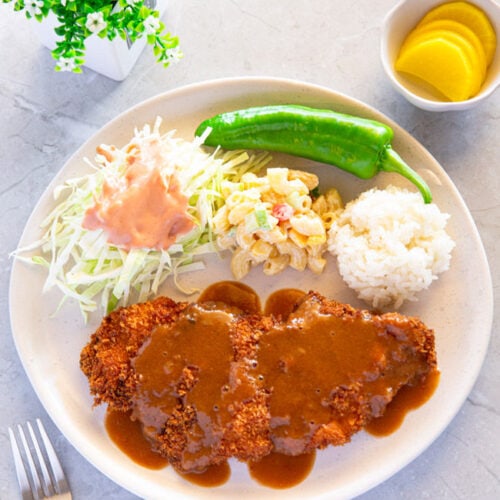
Donkatsu (Korean Style Pork Cutlet)
Ingredients
DONKATSU SAUCE
- 1/4 cup ketchup
- 1/2 cup tonkatsu sauce , bulldog brand preferred
- 2 Tbsp brown sugar
- 1 1/2 cup water
- 1/2 cup milk
- 30 g salted butter (1 ounce)
- 1 1/2 Tbsp plain flour
- 1/2 Tbsp cornstarch
- 1 Tbsp water
PORK CUTLET
- 600 g pork loin (1.3 pound), cut thinly for pork cutlet, about 1 cm / 0.4 inch thickness
- milk , enough to soak the meat
- 3 eggs
- 1/2 cup plain flour
- 1/2 tsp garlic powder
- 1/2 tsp onion powder
- 1 1/2 cup panko bread crumbs
SIDES (OPTIONAL)
- 250 g cabbage (9 ounce), thinly sliced
- 1/3 cup ketchup
- 1/3 cup mayonnaise
- non-spicy chili (e.g. long green pepper)
- ssamjang
- macaroni salad
- cooked rice
- pickled cucumber
- danmuji (yellow pickled radish)
- kimchi
Instructions
DONKATSU SAUCE
- Combine ketchup, tonkatsu sauce, brown sugar, water and milk in a large bowl or measuring cup. Mix well and set aside.
- Preheat a frying pan over medium heat, then add the butter. Once the butter has melted, add the flour to the pan. Stir well to ensure the flour is thoroughly mixed with the butter. Continue to cook over medium to medium-high heat until the mixture turns dark brown; this should take approximately 5-7 minutes, with occasional stirring. Then, reduce the heat to low.
- Pour the brown sauce from step 1 into the pan, stirring well. Increase the heat to medium-low or medium and cook until the sauce thickens, which should take approximately 8-10 minutes; remember to stir often. In a separate bowl, combine the cornstarch and water, whisking until the starch dissolves completely. Once the sauce in the pan has thickened slightly, add the slurry. Continue to stir frequently for an additional 5 minutes, or until the sauce reaches your desired thickness. Once done, either set it aside or reduce the heat to the lowest setting to keep it warm while the pork cutlet is being cooked.
PORK CUTLET
- Lightly score the meat in a diamond pattern using a knife, or use a mallet to tenderize it. Next, place the meat in a bowl and pour in the milk. Let the meat soak in the milk for 10 minutes. This will help further tenderize the meat and reduce any gamey smell. Afterward, drain the milk away and set the meat aside.
- Prepare two separate plates; fill one with a mixture of flour, garlic powder, and onion powder, and the other with panko bread crumbs. In a medium-sized bowl, crack the eggs and whisk them until fully combined. Arrange your workstation in the following order: a plate of pork, a plate of the flour mixture, a bowl of whisked eggs, and finally, a plate of panko bread crumbs.
- Thoroughly coat all sides of the pork with flour, then dip it into the beaten eggs. Finally, roll it in the panko bread crumbs until it’s fully covered. Repeat this process until all the meat is fully breaded.
- To prepare for frying, fill a fryer or large deep pan with a generous amount of oil and heat it. Make sure the container is wide enough to fully immerse at least one pork cutlet. Once the oil reaches 175°C (350°F), it is ready—this usually takes about five minutes on medium-high heat.
- Carefully place the pork cutlet in the sizzling oil and fry for about four minutes, flipping it every one to two minutes for even cooking. Once the pork cutlet is fully cooked and golden-brown, remove it from the oil and place on paper towels to absorb excess oil. Using a fine-mesh strainer, quickly skim off any remaining fried crumbs from the surface of the oil between batches. Repeat this process until all the cutlets are fried.
- Serve your chosen sides on a large plate, arranged around the edge. If serving cabbage, combine the ketchup and mayonnaise in a small bowl, then dollop the sauce over the cabbage. Place the cutlet in the center of the plate. Drizzle the sauce over it. Enjoy!
Notes
- 1 Tbsp = 15 ml, 1 Cup = 250 ml
Nutrition Info (per serving)
The nutrition information shown is an estimate provided by an online nutrition calculator. It should not be considered a substitute for a professional nutritionist’s advice.
